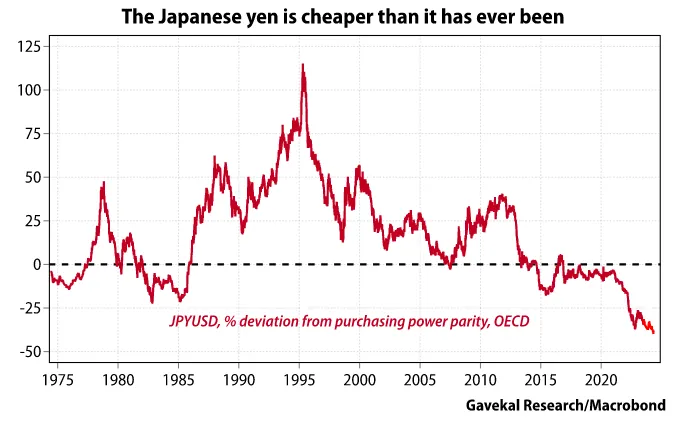I recently read Arthur Hayes' "The Easy Button" and wanted to articulate his thesis.
Arthur's macro methodology amounts to finding hidden or misunderstood mechanisms for printing dollars. He assumes Bitcoin is a leading indicator of global liquidity. An example of this modus operandi is his piece on the Bank Term Funding Program (BTFP) in March 2023.
In this recent piece, his thesis is that the Japanese yen to U.S. dollar exchange rate (USDJPY) is the most important macro indicator for crypto. His reasoning is that the most likely liquidity injection mechanism is a potential joint initiative between the U.S. Fed and the Japanese Ministry of Finance (MOF), and that USDJPY is the clearest metric to monitor the start of this program.
The yen issue
Why would Japan and the US enter an agreement? Arthur believes the yen’s situation is a problem for Japan, the US, and China. Of these three, China is feeling the strongest pain, and he argues they have the leverage to pressure the US into resolving the yen crisis.

The weak yen makes China less competitive than Japan in exporting important goods like cars. This is problematic because China heavily relies on exports to escape its deflationary spiral. It also needs to print more money through credit. However, a deflationary economy makes it difficult and they can't print money due to potential capital flight, higher energy and food import prices, and ultimately possible social disorder.
China has political leverage on the US government fighting dearly for re-election. They can pressure on a sensitive issue: manufacturing jobs. By manipulating the dollar-yuan exchange rate, they can make it more or less competitive for US companies to manufacture abroad. In a tense electoral year where manufacturing-heavy states are crucial constituencies, the USG likely can’t ignore that threat.
As a result, Arthur believes China can pressure the US to instruct Japan to strengthen the yen. This raises the question, why is Japan so susceptible to influence?
Japan is also in a predicament: rates are too low, leading to capital flights to USD, but they cannot raise rates without destroying the value of Japanese Government Bonds (JGB), which the Bank of Japan (BOJ) holds the largest share of. If Japan were to match USTs yields, it would result in a $1.05 trillion mark-to-market loss for a bank that has $32.25 billion of equity capital (he estimates).
In turn, this also presents a challenge for the U.S. If Japan were to raise rates, it would compel domestic capital to sell USTs to raise dollars and buy JGBs. It's not in the US interest to see trillions of USTs and US equities being forcibly sold, so BOJ rate hikes are not a viable option.
So the yen situation is a headache for everyone, and rate hikes are out of the equation - what then is a good solution?
The USDJPY swap solution
Arthur expects an easy solution with an unlimited dollar-yen currency swap between the Fed and the BOJ.
Say Japan needs $1 trillion to strengthen the yen from 161 to 100. The Fed would swap that amount for the equivalent in Yen, in a transaction where the Fed prints dollars and the BOJ prints yen, costing them nothing. The dollars leave the BOJ balance sheet to buy yen in the open market, but the yen on the Fed balance sheet essentially leaves the system because the Fed has no use for yen.
The net result is that the dollar weakens as its supply has increased relative to other currencies. The yen appreciates from the BOJ's purchasing yen on open markets and the decreased effective overall supply (think of a % of the circulating supply as locked in the Fed balance sheet)
Arthur believes this is the most likely scenario because it benefits everyone:
China can print more yuan without affecting CNYUSD rates and battle deflation. The yuan becomes weaker relative to the yen, restoring their export competitiveness.
The U.S. eases China pressure. They also experience asset appreciation due to a weaker dollar, benefiting markets and taxes.
Japan's domestic inflation declines, but with lower export competitiveness as a consequence.
But more importantly, if crypto indeed reacts to market liquidity, we're going higher.
How to monitor the situation
The core indicator to monitor this thesis is the USDJPY . Arthur expects a point when JPY is too weak and the program rolls in (around 200, expected in fall). Once it rolls in, it would be visible on a website that tracks USD liquidity swaps. Anything in the billions is significant.

Two other things that could disprove this thesis:
A substantial rate hike by the BOJ (>2%)
China devalues yuan or pegs it to gold
And that's why USDJPY is important: it's a liquidity printing mechanism, and when the swap policy comes into play, Bitcoin ETFs are likely a great buy to hedge against fiat debasement.